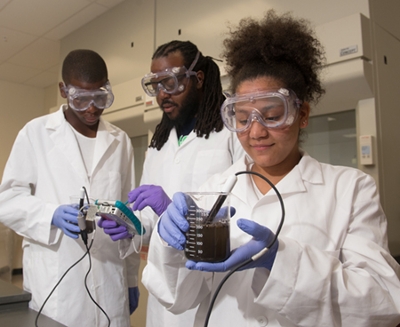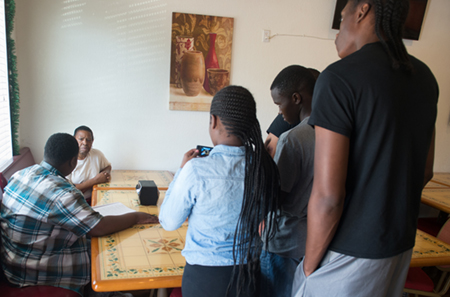 Students from East St. Louis are documenting the culture and history of their hometown, while gaining valuable knowledge and computer skills, by participating in Southern Illinois University Edwardsville’s Digital East St. Louis program.
Students from East St. Louis are documenting the culture and history of their hometown, while gaining valuable knowledge and computer skills, by participating in Southern Illinois University Edwardsville’s Digital East St. Louis program.
Now in its third year, the program continues to incorporate new interactive projects for the students, with the underlying goal of inspiring a love for science, technology, engineering and mathematics (STEM) through creative digital humanities content. Digital East St. Louis is supported by an $846,000 Innovative Technology Experiences for Students and Teachers (ITEST) grant awarded to SIUE from the National Science Foundation (NSF).
“We want to give kids a chance to explore their city’s history and culture on their own terms, and share what they’ve learned with their community,” said Matt Johnson, instructional design and curriculum specialist with the SIUE STEM Center. “Digital East St. Louis promotes lifelong STEM learning by making STEM skills relevant to their lives and using them to communicate their interests and learning to broader audiences in new and innovative ways.”
This summer’s activities have ranged from conducting environmental science research and web coding to producing video documentaries. The students’ work is featured on their website, EastStLouisCulture.org.
 “The ultimate goal of this program is to prepare students to be successful in their future education and careers,” said Sharon Locke, PhD, principal investigator and director of the SIUE STEM Center. “No matter their future aspirations, the array of experiences the students are gaining through Digital East St. Louis is enhancing their 21st century skills, including teamwork, communication and critical thinking.”
“The ultimate goal of this program is to prepare students to be successful in their future education and careers,” said Sharon Locke, PhD, principal investigator and director of the SIUE STEM Center. “No matter their future aspirations, the array of experiences the students are gaining through Digital East St. Louis is enhancing their 21st century skills, including teamwork, communication and critical thinking.”
“I’m interested in going to medical school,” said Alyssa Gines, a rising sophomore at East St. Louis Senior High School, as she worked in a science lab at SIUE. “I’m a curious person, so this environmental science experiment is interesting.”
Gines and fellow student Da’Quain White collected soil samples from industrial areas in Sauget and East St. Louis. They worked with instructor Johnathan Tate to determine the overall health of the soil.
“To talk about the history of East St. Louis, you have to include the industrial waste that the city has been exposed to over the years,” Tate explained. “This activity is about communicating environmental science through more than just recycling. The students are discovering how science can be used to communicate about social issues.”
Meanwhile, students interested in journalism and video production visited a community staple, Sherry J’s restaurant. They interviewed an employee and gathered video footage around town for the documentary they’re creating on soul food.
“Not a lot of kids get to do something like this,” said 13-year-old Janiyha Cherry, who attends Mason Clark Middle School. “We’re doing this to add more content to our website that shows the positive things about East St. Louis. The history of East St. Louis is interesting. Every day I go home and say, ‘mama, look what I learned!”
“This program introduces students to STEM concepts through other content,” said instructor Jenna Loveless. “That’s why the students are showcasing the culture and history of the city by conducting interviews with local people, and creating podcasts and documentaries. It makes the idea of STEM less intimidating.”
“I’ve learned a lot of things that will help me in the future,” said 15-year-old East St. Louis Senior High School student Lee Sayles. “The instructors have taught me how to strive for excellence and chase my dreams. I’m taking their words and trying to put them into action.”
Digital East St. Louis runs four weeks through the summer, as well as 15 Saturdays during the school year. Through the NSF grant, up to 50 students can participate. Students receive breakfast, a snack and lunch, along with free transportation.
It is a multidisciplinary effort led by Locke, Jessica DeSpain, associate professor in the Department of English Language and Literature and co-director of the Interdisciplinary Research and Informatics Scholarship (IRIS) Center at SIUE; and Liza Cummings, assistant professor in the Department of Teaching and Learning.
Photos: Digital East St. Louis instructor Johnathan Tate (middle) leads soil testing in an SIUE science laboratory with high school students Da’Quain White (L) and Alyssa Gines (R).
A group of students participating in SIUE’s Digital East St. Louis program record an interview with an employee at Sherry J’s restaurant in East St. Louis. The interview will be part of a documentary they are creating on the topic of soul food.